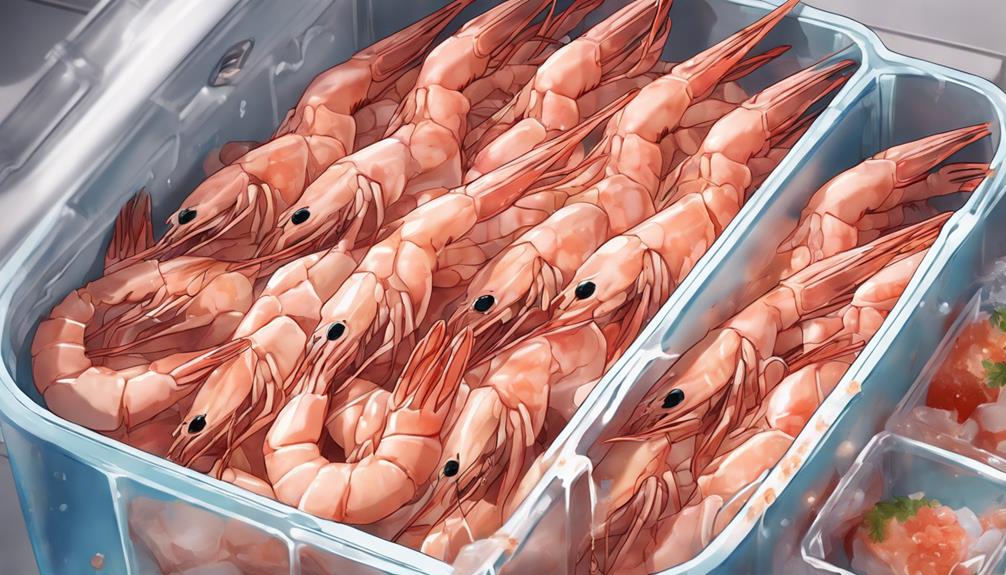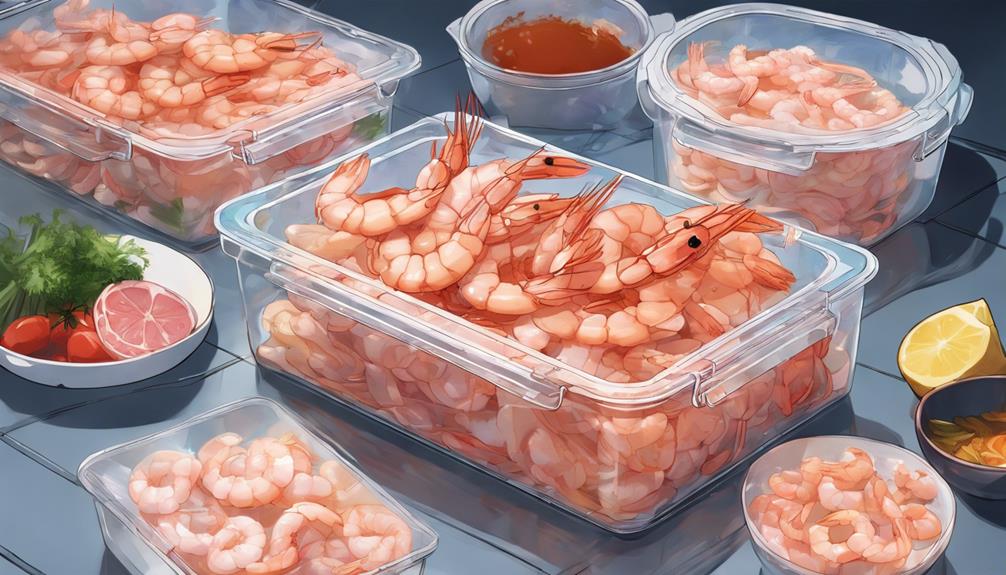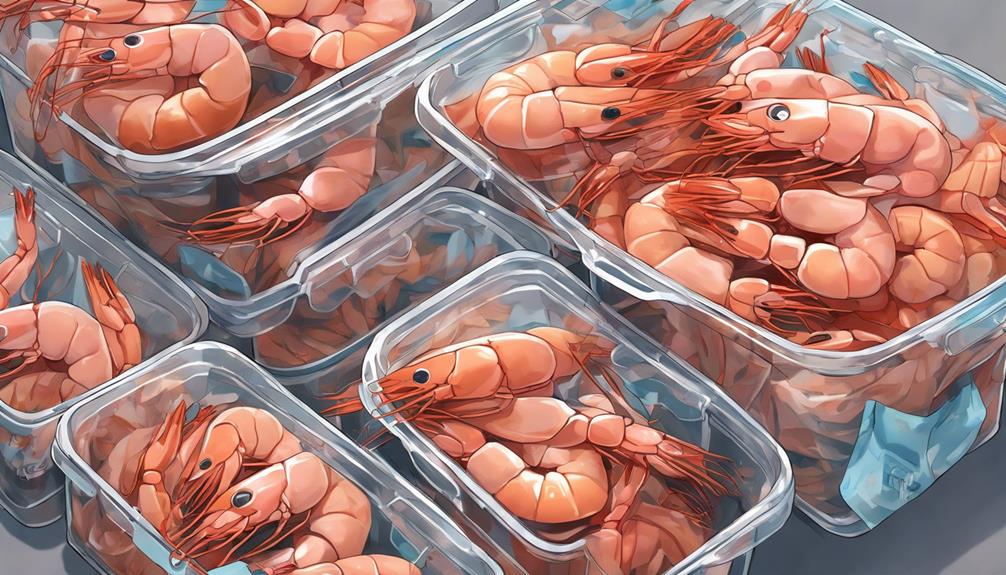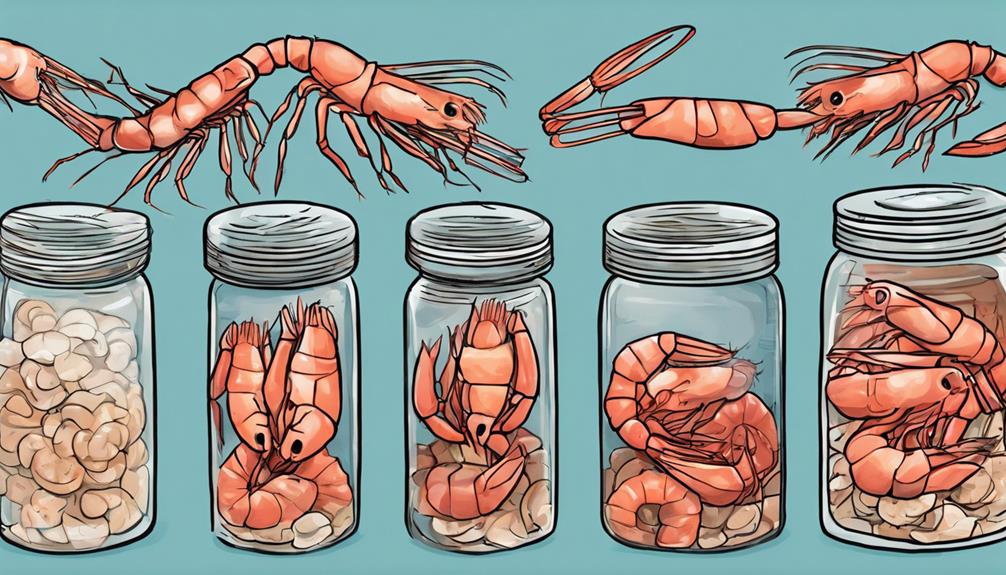When you want to store cooked shrimp to enjoy later in the week, remember to keep them fresh by refrigerating them in an airtight container or resealable bag once they've cooled to room temperature. Adding a slice of lemon or fresh parsley can boost the flavor. If you're thinking about freezing them, quick freeze on a baking sheet before transferring to a freezer bag. Proper storage in airtight containers or bags helps maintain their taste and quality. Remember, freshness is key for a delightful meal down the line.
Main Points
- Refrigerate in airtight containers post cooling.
- Consume within 3-4 days for best quality.
- Label containers with storage date for tracking.
- Freeze in airtight bags for longer preservation.
- Avoid cross-contamination for safety and freshness.
Refrigerating Cooked Shrimp

When storing cooked shrimp in the refrigerator, freshness is crucial to preserving their delicate flavor and texture. To guarantee your cooked shrimp stays fresh, place them in an airtight container or a resealable plastic bag. Before storing, make sure the shrimp have completely cooled down to room temperature.
Consider adding a slice of lemon or a sprig of fresh parsley to the container to enhance the shrimp's flavor while in the fridge. Remember, cooked shrimp should be consumed within 3 to 4 days to maintain peak taste and quality.
Avoid placing the shrimp in the door of the refrigerator as the temperature fluctuates more there. Instead, store them towards the back where it's cooler and more consistent. If you notice any off smells or sliminess, it's best to discard the shrimp to prevent any potential foodborne illnesses.
Freezing Cooked Shrimp
To preserve the freshness and quality of your cooked shrimp for an extended period, freezing them is a convenient and practical option. Freezing cooked shrimp properly can help maintain their flavor and texture, ensuring they're ready to use whenever you need them.
Here are some tips for freezing cooked shrimp effectively:
- Quick Freeze: Spread the cooked shrimp out on a baking sheet in a single layer and place them in the freezer for a couple of hours until they're firm. This prevents them from sticking together in a clump.
- Airtight Packaging: Once the shrimp are frozen, transfer them to airtight freezer bags or containers. Make sure to remove as much air as possible before sealing to prevent freezer burn.
- Labeling and Dating: Remember to label the bags or containers with the freezing date so you can keep track of how long they've been stored. This helps you maintain freshness and quality.
Using Airtight Containers

Consider selecting a sturdy, airtight container with a secure lid to store your cooked shrimp efficiently and maintain their freshness. Airtight containers help prevent air from entering, which can cause the shrimp to spoil faster. Look for containers made of glass or BPA-free plastic to guarantee they're safe for storing food.
When transferring the shrimp into the container, make sure they're completely cooled to room temperature to avoid condensation inside the container, which can lead to bacterial growth.
Once you have placed the shrimp in the airtight container, seal it tightly to establish a secure environment. Store the container in the refrigerator rather than at room temperature. The cool temperature of the fridge will help keep the shrimp fresh for a longer period.
Remember to label the container with the date you stored the shrimp to track its freshness and consumption timeline. By using airtight containers, you can preserve the flavor and texture of your cooked shrimp for delicious meals throughout the week.
Avoiding Cross-Contamination
To maintain the quality of your cooked shrimp and prevent the risk of contamination, always use separate cutting boards and utensils for raw and cooked seafood. Cross-contamination can occur when harmful bacteria from raw seafood come into contact with cooked food, potentially leading to foodborne illnesses.
Here are some tips to help you avoid cross-contamination:
- Designate specific cutting boards: Use one cutting board solely for raw seafood and another for cooked shrimp to prevent any bacteria from transferring between the two.
- Use separate utensils: Have dedicated utensils for handling raw seafood and a different set for cooked shrimp to avoid any potential cross-contamination.
- Clean surfaces thoroughly: After preparing raw shrimp, make sure to clean all surfaces, utensils, and cutting boards with hot, soapy water to eliminate any lingering bacteria.
Proper Labeling and Dating

Properly labeling and dating your cooked shrimp is essential for maintaining freshness and ensuring food safety. When storing cooked shrimp, grab some masking tape and a marker. Write down the date you cooked the shrimp and stick the label on the container; this simple step can save you from the dreaded question, 'Is this still good?' By dating the shrimp, you can easily keep track of when it was made and how long it has been in the fridge.
Moreover, labeling isn't just about the date; it's also helpful to jot down any seasoning or sauce you used. This information can guide you on what flavors to pair the shrimp with when reheating them later in the week. Additionally, if you made different batches of shrimp with varying ingredients or cooking methods, labeling will prevent any mix-ups and help you choose the right batch for your meal. So, don't underestimate the power of a small label; it can make your shrimp storage a breeze!
Reheating Cooked Shrimp
When it comes to enjoying your cooked shrimp again, reheating them to perfection is key to savoring their flavors and textures. Here are some tips to make sure your reheated shrimp tastes just as delicious as when it was freshly cooked:
- Steam Them: Place your cooked shrimp in a steamer basket over boiling water for a few minutes until they're heated through. This method helps retain moisture and prevents the shrimp from becoming rubbery.
- Sauté in Butter: Heat a pan, add a bit of butter, and toss in your shrimp. Sauté them for a couple of minutes until they're heated evenly. The butter adds a rich flavor to the shrimp.
- Microwave with Care: If you're short on time, microwave your shrimp in short intervals to avoid overcooking. Place a damp paper towel over the shrimp to help keep them moist while reheating.
Conclusion
So there you have it – storing cooked shrimp properly is crucial to enjoying them later in the week.
Did you know that the average American consumes about 4 pounds of shrimp per year?
By following these simple steps like refrigerating or freezing your cooked shrimp in airtight containers, you can guarantee they stay fresh and delicious for future meals.
Remember to label and date your containers, avoid cross-contamination, and reheat your shrimp safely for a tasty treat every time! Proper food handling practices are essential to ensure both safety and flavor. While rinsing raw shrimp before cooking can help remove any surface debris or impurities, be cautious to minimize splatter, as this can spread bacteria. Always store your shrimp at the correct temperature and use fresh, quality ingredients for the best results.
